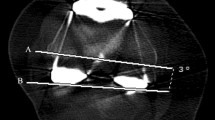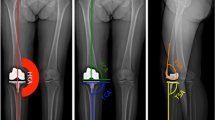Abstract
Purpose
Computer navigation increases accuracy and precision of component alignment in total knee arthroplasty (TKA) compared to the manual technique, but is often associated with increases in surgical time. In a previous cadaver study, we demonstrated a significant improvement in guide positioning precision, final bone cut precision, and procedure length when using adjustable cutting blocks (ACB) compared to conventional cutting blocks (CCB) in computer-navigated TKA. The aim of this study was to evaluate the use of ACB in vivo.
Methods
We radiographically compared component alignment and mechanical leg alignment, as well as tourniquet time, in 94 patients who underwent TKA using either ACB (N = 30) or CCB (N = 64).
Results
Postoperative mechanical alignment variability was significantly less in the ACB group (SD = 1.7°) than in the CCB group (SD = 2.7°). Tourniquet time was significantly reduced by 14.8 min in the ACB group compared to the CCB. Differences in component alignment were not significant.
Conclusion
ACB for TKA significantly reduced postoperative mechanical alignment variability and tourniquet time compared to conventional navigated instrumentation, while providing equal or better component alignment.
Level of evidence
III.




Similar content being viewed by others
References
Barwell J, Anderson G, Hassan A, Rawlings I (1997) The effects of early tourniquet release during total knee arthroplasty: a prospective randomized double-blind study. J Bone Joint Surg Am 79(2):265–268
Bathis H, Perlick L, Tingart M, Luring C, Zurakowski D, Grifka J (2004) Alignment in total knee arthroplasty. A comparison of computer-assisted surgery with the conventional technique. J Bone Joint Surg Br 86(5):682–687
Bolognesi M, Hofmann A (2005) Computer navigation versus standard instrumentation for TKA: a single-surgeon experience. Clin Orthop Relat Res 440:162–169
Bozic KJ, Maselli J, Pekow PS, Lindenauer PK, Vail TP, Auerbach AD (2010) The influence of procedure volumes and standardization of care on quality and efficiency in total joint replacement surgery. J Bone Joint Surg Am 92(16):2643–2652
Dutton AQ, Yeo SJ, Yang KY, Lo NN, Chia KU, Chong HC (2008) Computer-assisted minimally invasive total knee arthroplasty compared with standard total knee arthroplasty. A prospective, randomized study. J Bone Joint Surg Am 90(1):2–9
Hasegawa M, Yoshida K, Wakabayashi H, Sudo A (2011) Minimally invasive total knee arthroplasty: comparison of jig-based technique versus computer navigation for clinical and alignment outcome. Knee Surg Sports Traumatol Arthrosc 19(6):904–910
Katz JN, Barrett J, Mahomed NN, Baron JA, Wright RJ, Losina E (2004) Association between hospital and surgeon procedure volume and the outcomes of total knee replacement. J Bone Joint Surg Am 86-A(9):1909–1916
Kellgren JH, Lawrence JS (1957) Radiological assessment of osteo-arthrosis. Ann Rheum Dis 16(4):494–502
Klima S, Zeh A, Josten C (2008) Comparison of operative time and accuracy using conventional fixed navigation cutting blocks and adjustable Pivotal cutting blocks. Comput Aided Surg 13(4):225–232
Kosashvili Y, Mayne IP, Trajkovski T, Lackstein D, Safir O, Backstein D (2010) Influence of sex on surgical time in primary total knee arthroplasty. Can J Surg 53(4):256–260
Koulalis D, O’Loughlin PF, Plaskos C, Kendoff D, Cross MB, Pearle AD (2010) Sequential versus automated cutting guides in computer-assisted total knee arthroplasty. Knee. doi:10.1016/j.knee.2010.08.007
Koulalis D, O’Loughlin PF, Plaskos C, Kendoff D, Pearle AD (2010) Adjustable cutting blocks for computer-navigated total knee arthroplasty a cadaver study. J Arthroplasty 25(5):807–811
Luring C, Beckmann J, Haibock P, Perlick L, Grifka J, Tingart M (2008) Minimal invasive and computer assisted total knee replacement compared with the conventional technique: a prospective, randomised trial. Knee Surg Sports Traumatol Arthrosc 16(10):928–934
Manzotti A, Cerveri P, De Momi E, Pullen C, Confalonieri N (2010) Relationship between cutting errors and learning curve in computer-assisted total knee replacement. Int Orthop 34(5):655–662
Mason JB, Fehring TK, Estok R, Banel D, Fahrbach K (2007) Meta-analysis of alignment outcomes in computer-assisted total knee arthroplasty surgery. J Arthroplasty 22(8):1097–1106
Novak EJ, Silverstein MD, Bozic KJ (2007) The cost-effectiveness of computer-assisted navigation in total knee arthroplasty. J Bone Joint Surg Am 89(11):2389–2397
Ritter MA, Davis KE, Meding JB, Pierson JL, Berend ME, Malinzak RA (2011) The Effect of Alignment and BMI on Failure of Total Knee Replacement. J Bone Joint Surg Am 93(17):1588–1596
Ritter MA, Faris PM, Keating EM, Meding JB (1994) Postoperative alignment of total knee replacement. Its effect on survival. Clin Orthop Relat Res 299:153–156
Rosenberger RE, Hoser C, Quirbach S, Attal R, Hennerbichler A, Fink C (2008) Improved accuracy of component alignment with the implementation of image-free navigation in total knee arthroplasty. Knee Surg Sports Traumatol Arthrosc 16(3):249–257
Sampath SA, Voon SH, Sangster M, Davies H (2009) The statistical relationship between varus deformity, surgeon’s experience, BMI and tourniquet time for computer assisted total knee replacements. Knee 16(2):121–124
Sharma L, Song J, Felson DT, Cahue S, Shamiyeh E, Dunlop DD (2001) The role of knee alignment in disease progression and functional decline in knee osteoarthritis. JAMA 286(2):188–195
Slover JD, Tosteson AN, Bozic KJ, Rubash HE, Malchau H (2008) Impact of hospital volume on the economic value of computer navigation for total knee replacement. J Bone Joint Surg Am 90(7):1492–1500
The Chinese University of Hong Kong stats toolbox: intraclass correlation. http://departmentobgcuhkeduhk/researchsupport/IntraClass_correlationasp
Willis-Owen CA, Konyves A, Martin DK (2010) Factors affecting the incidence of infection in hip and knee replacement: an analysis of 5277 cases. J Bone Joint Surg Br 92(8):1128–1133
Conflict of interest
Dr. Plaskos is an employee of Praxim Inc., manufacturer of the navigation system used in this study. None of the other authors have any conflicts of interest to report.
Author information
Authors and Affiliations
Corresponding author
Rights and permissions
About this article
Cite this article
Suero, E.M., Plaskos, C., Dixon, P.L. et al. Adjustable cutting blocks improve alignment and surgical time in computer-assisted total knee replacement. Knee Surg Sports Traumatol Arthrosc 20, 1736–1741 (2012). https://doi.org/10.1007/s00167-011-1752-1
Received:
Accepted:
Published:
Issue Date:
DOI: https://doi.org/10.1007/s00167-011-1752-1




